| |
Defenses of Manila Bay |
|
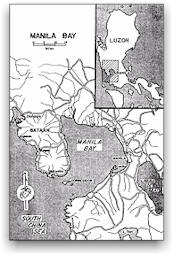 |
Four islands protected the mouth of Manila Bay from attack. Corregidor,
the largest island, was fortified prior to World War I with powerful
coastal artillery and named Fort Mills. The tadpole shaped island lay
two miles from Bataan, and was only 3-1/2 miles long and 1-1/2 miles
across at its head. This wide area, known as Topside, contained most of
Fort Mills' 56 coastal artillery pieces and installations.
The next feature
proceeding east from Topside was Middle side, a small plateau containing
more battery positions and barracks. East from Middleside was
Bottomside, the low ground where a dock area and the civilian town of
San Jose was located. Further east was headquarters, hospital, and
communication tunnels contained within Malinta Hill. The narrow tail of
the island continued east, with a small landing strip, Kindley Field,
until ending among the rocky beaches of Hooker Point.
Fort Hughes lay on
nearby Caballo Island, and contained 13 heavy guns, while further south
on El Fraile island was Fort Drum, an island which had been leveled and
reformed into a "concrete battleship," with two steel turrets mounting
four 14-inch guns. Fort Frank, containing 14 large-caliber cannon on
Carabao Island, lay only 500 yards from the Cavite shoreline and was
perhaps most vulnerable to attack.
|
| |
Corregidor |
|

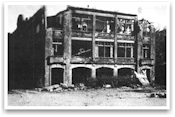
Middleside Barracks, March 1942. The barracks housed the reserve
company of the 2d Battalion, 4th Marines during the siege.
Austin C.Shofner Papers, Personal Papers Collection, MCHC
|
At 1000, 26 December, the 4th Marines began to move to Corregidor. More
than 400 Marines of the 1st Separate Marine Battalion were loaded on
board lighters and taken across the channel. They were then transported
by narrow gauge railway to Middleside Barracks. The forward echelon of
the Headquarters and Service Companies and the 2d Battalion loaded on a
minesweeper and lighters just after darkness the following day. Shortly
after midnight on 27 December, the 336 Marines and their equipment were
completely unloaded on Corregidor.
Two days later at
2010, the 1st Battalion and the remainder of the regiment completed the
transfer to Corregidor's North Dock. A 1st Battalion Marine private
busily carried a box of .30-caliber ammunition weighing more than 96
pounds to the dock. Lieutenant Colonel Beecher stepped in front of the
sweating Marine and took the box out of his hands. He then dropped the
ammunition off the dock into the water. The private stared dumbfounded
as Beecher informed him, "You're carrying blanks; we are not using them
anymore." The 4th took six months of rations for 2,000 men, 10 units of
fire for all weapons, a two-year supply of summer clothing, and
medicines and equipment for a 100-bed hospital, to Corregidor.
Marines were first
quartered in the concrete barracks on Middleside. When they inquired of
their Army comrades about protection from bombing, they were assured the
barracks were bombproof. Captain John Clark wrote later, "A feeling of
safety and security came over us as we reached the Rock. We were told it
was impregnable, and that we had nothing to fear from Japanese attack."
At 0800, 29 December,
Colonel Howard reported to Major General George F. Moore, commanding the
Harbor Defenses of Manila and Subic Bays. He was immediately appointed
commanding officer of beach defense, Corregidor. Howard then began a
prompt inspection of the current beach defenses.
|
|
|
First Bombing |
|
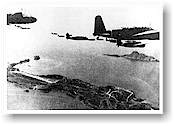
Japanese aircraft prepare to bomb Corregidor.
Photo courtesy of
Dr. Diosdado M. Yap |
At 1140 that same
day a flight of Japanese aircraft approached Corregidor. Air-raid sirens
sounded, but most of the 4th Marines paid little attention to them,
believing in the safety of Corregidor's antiaircraft defenses.
Lieutenant Sidney Jenkins remembered, "bombs screaming to earth with
shattering explosions, the crack of AA guns, the neat 'plop plop' of the
AA shells bursting all over the sky . . . there we were, the whole
regiment flat on our bellies on the lower deck of Middleside Barracks."
Marines in the upper
decks of Middleside Barracks sprinted for the lower deck for protection.
Most of the bombs that hit the building exploded on the second and third
decks, but Private First Class Don Thompson and 20 other Marines on the
first deck felt an explosion and a shower of cement dust. He looked up
and saw blue sky though a hole in the ceiling of the supposedly
bombproof barracks. Bombs continued to fall for the next two hours.
Corporal Verle W. Murphy died of multiple wounds to the head and chest
while trying to clear the building, and nine Marines were wounded in the
attack.
Private First Class
Charles R. Greer and Private Alexander Katchuck noticed two wounded men
in an abandoned truck. Greer and Katchuck left their shelter and drove
the truck to the hospital despite the falling bombs. They were awarded
Silver Star Medals, the first Marines to be awarded an Army decoration
in World War II, and the first to be mentioned in General MacArthur's
dispatches.
Bombs destroyed or
damaged the hospital, antiaircraft batteries, Topside and Middleside
Barracks, the Navy fuel depot, and the officers club. Smoke cast a black
pall over the island as numerous wooden buildings caught fire. Power,
water, and communication lines were disrupted. Total casualties on
Corregidor mounted to 20 killed and 80 wounded.
After the Japanese
bombing ended, the 4th Marines was assembled in front of the barracks to
ascertain casualties. As the men stood in formation, someone dragged a
sea bag down the stairs of the barracks, which made a noise like falling
bombs. Instantly, the men broke and ran "pell mell back into the safe
barracks" only to reemerge laughing once the origin of the sound was
determined.
Japanese bombers
reappeared over Corregidor at 1134, 2 January and bombed the island for
more than three hours. Private First Class Verdie G. Andrews was killed
by debris from the explosions and six other Marines were wounded.
Periodic bombing continued over the next four days resulting in one
Marine killed and another wounded. Only two more raids occurred in
January allowing the Marines to improve their positions considerably. On
29 January Japanese aircraft dropped only propaganda leaflets which
greatly amused the beach defenders.
|
|
|
Deployment |
|
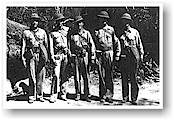
Five
members of the 4th Marines pose for the camera on Corregidor. All
Marines were required to carry their gas masks at all times should the
Japanese use chemical agents.
Department of Defense Photo (USMC) W-PHI-2
|
On 29-30 December the 4th Marines moved from its barracks into field
positions. The 1st Battalion took the east sector, from Malinta Hill to
Hooker Point on the tail of the island. The 2d Battalion moved into the
west sector and the 1st Separate Marine Battalion was assigned the
middle sector. On 1 January 1941, this battalion was officially
redesignated 3d Battalion, 4th Marines. Forty four Marines of the
battalion were detailed for antiaircraft defense for Batteries Wheeler
and Cheney. In addition, 46 Marines in two platoons of the 3d Battalion
under Second Lieutenant Frederick A. Hagen were deployed with .30- and
.50-caliber machine guns to provide antiaircraft fire and beach defense
of Fort Hughes. Another 14 Marines of the 3d Battalion were deployed to
Fort Drum for the same purpose.
Work began rapidly on
construction of beach defenses. Typical was the reaction of Lieutenant
Colonel Beecher when he first inspected his defense area. He later
wrote, "The task confronting us was appalling. With 350 men there were
3,500 to 4,000 yards of possible landing beach to defend." The Marines
began to build barbed wire barriers, tank traps, bunkers, and trench
systems. Working parties began at first light in the morning and halted
only at noon for a rest period in place of lunch. The work progressed
well, slowed only by Japanese shelling, bombing, and darkness.
Tools were carefully
guarded, as Lieutenant Jenkins remembered, "We took care of our tools
like gems." The Marines ran short of sandbags, so discarded powder cans
from the coastal artillery guns were filled with dirt and used in their
place. Bottles were filled with gasoline to make "Molotov cocktails," to
be dropped over cliffs on the Japanese. Empty gasoline drums were filled
with dirt and rock and set up as tank traps on trails leading from the
beach. Each position was carefully camouflaged for protection and dummy
positions were also constructed to attract enemy fire.
Marines of Company B
located Army aircraft bombs, and wooden chutes were constructed to drop
the bombs on landing areas. A second line of defense and reserve
positions were also built behind the front line beach defenses, with the
hope of eventual reinforcement.
|
|
|
The Bombardment Continues |
|

An unexploded bomb at Middleside, Corregidor, March 1942.
Austin C. Shofner Papers, Personal Papers Collection, MCHC

LtCol Herman R. Anderson stands on the beach on
Corregidor with the assembled officers of 2d Battalion, 4th
Marines and several Filipino officers. Note the thick layers of
oil on the beaches from ships sunk in Manila Bay.
Department of Defense Photo (USMC) 58736
|
On 6 February, Japanese artillery opened fire on Corregidor and the
fortified islands from positions in Cavite Province. The forts were
shelled eight more days and bombed twice in February. Occasional
shelling and bombing hit the fortified islands until 15 March, when the
Japanese began preparations to renew their offensive on Bataan. The
bombing and artillery raids now continued unabated until the end of the
siege. The Japanese conducted attacks spaced over every 24-hour period
after 24 March to prevent any rest by the defenders. Japanese harassing
artillery fires, conducted every 25-30 minutes throughout the night,
caused the Marines to dub the annoying cannon "Insomnia Charlie." The
artillery spotting balloon over Bataan was nicknamed "Peeping Tom."
The events of 30
March typify the constant Japanese bombardment. There were two periods
of shelling, beginning at 0950 and 1451, and six bombing raids,
beginning at 0040 and spaced throughout the day. One Marine, Private
First Class Kenneth R. Paulin of Company M, 3d Battalion, was killed
during the day by shellfire from the Cavite shore. The bombing raids
finally ended at 2205. The attacks were renewed at 0102 on the same
schedule, except 10 bombing raids occurred on 31 March.
At this time, the
major problems facing Major General Jonathan Wainwright, USA, commander
of U.S. Forces on the Bataan Peninsula, were dwindling food supply and
an increased disease rate. By March, the daily ration of food for the
men on Bataan was 1,000 calories with food for Corregidor rationed to
last until the end of June 1942. On 27 March, Wainwright telegraphed Mac
Arthur in Australia to report the June deadline and asked for supplies.
He also stated that "with ample food and ammunition we can hold the
enemy in his present position, I believe, indefinitely"
On 1 April, General
Wainwright recognized that little or no food could arrive through the
Japanese blockade and ordered a new reduced ration. The 4th Marines and
other defenders of Corregidor now consumed 30.49 ounces of food per day:
8 ounces of meat, 7 ounces of flour, 4 ounces of vegetables, 3 ounces of
beans and cereals, 2.5 ounces of rice, 3 ounces of milk, and
approximately 3 ounces of miscellaneous food stuffs.
"We were hungry all
the time," remembered Private First Class Ben L. Lohman, "We ate mule
meat . . . when the mules were killed in the bombing . . . they'd bring
the carcasses down and we'd eat 'em." Drinking water was distributed
only twice a day in powder cans, but bombing and shelling often
interrupted the resupply. The staple food for the 4th Marines was
cracked wheat, sometimes made into dumplings, sometimes served with
syrup. The continued lack of a proper diet created major problems for
the 4th Marines, as men were weakened and lacked reliable night vision.
Some Marines lost up to 40 pounds during the bombardment.
On 9 April, Bataan
fell to the Japanese after a final offensive broke through the USAFFE
defenses trapping more than 75,000 men. Battery C managed to escape at
the last minute, but the Marine guards at USAFFE headquarters and the
Air Warning Detachment were taken prisoner, and endured the infamous
Bataan Death March. The Japanese wasted little time before focusing
their attention on Corregidor, intensifying their bombardment of the
island the same day Bataan fell.
Although food was in
short supply on Corregidor. ammunition was relatively plentiful. As of 7
April, the island had 5,177,900 rounds of armor piercing, clipped, and
tracer .30-caliber ammunition and a total of 161,808 rounds of
.50-caliber ammunition. Gen Wainwright wrote, "Our flag still flies on
this beleaguered fortress." and added in his memoir, "I meant to see it
keep flying."
|
|
|
Reinforcements |
|
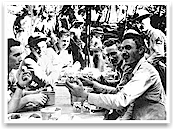
A Marine shows his friends his portion of a resupply of precious
cigarettes brought into Corregidor by submarine.
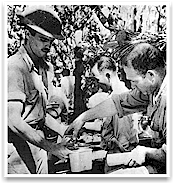
A new supply of cigarettes has just arrived in the Philippines
and the Marines are given their ration along with chow.
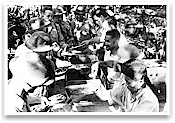
Marines break for one of their two meals a day on Corregidor. |
As men became available on Corregidor from January until after the fall
of Bataan, they were integrated into the 4th Marines to support beach
defense. In February, 58 sailors formerly of the USS Canopus were
organized as a reserve company Lieutenant Clarence Van Ray with Platoon
Sergeant Leslie D. Sawyer and Sergeant Ray K. Cohen trained and equipped
the sailors into an efficient fighting force. Ten Marines and 40 more
sailors were added to the company after the fall of Bataan.
The largest group of
reinforcements arrived after the fall of Bataan. In the days following 9
April, 72 officers and 1,173 enlisted men from more than 50 different
organizations were assigned to the 4th Marines, making the Marine
regiment one of the most unusual units in Marine Corps history. These
reinforcements included members of the Navy, the Army, the Philippine
Army and Philippine Scouts. Sailors stranded on land after the loss of
their ships found themselves alongside engineers, tankers, and aviators
whose units were captured on Bataan. Filipino Scouts were assigned with
members of the islands' Constabulary to the 4th Marines. Unfortunately,
very few of the reinforcements were trained or equipped for ground
combat. By 29 April, the 4th Marines numbered 229 officers and 3,770
men, of whom only about 1,500 were Marines.
The
Formation of the 4th Battalion
With Bataan on the
brink of falling, Captain John H. S. Dessez, the commander of the Navy
Base at Mariveles requested permission to transfer his 500 sailors to
Corregidor. Approval was granted with the condition that these men would
be part of the beach defense force. On 10 April, the 4th Battalion was
formed under the command of Major Francis H. "Joe" Williams. His command
was built with nine Army officers and 16 Navy officers and warrant
officers commanding 272 enlisted men. This joint service battalion
bivouacked in Government Ravine near Battery Geary and began to train
for ground combat.
Four companies were
organized in the battalion and lettered Q, R, S, and T. Companies Q and
R were commanded by Army officers and S and T by Navy officers. Rifles
still packed in cosmoline, a greasy protective coating, were issued to
the sailors. This presented interesting cleaning problems to the
inexperienced mariners. However, rifles were all that was issued to the
battalion in the way of equipment. There were no helmets, cartridge
belts, or even first aid kits.
Williams at once
began weapons training for his sailors. With no rifle range available,
the blue-jackets used floating debris in Manila Bay as targets on which
to sight in their rifles. Some of the Navy personnel had not fired a
weapon in almost 20 years. Training proceeded with cover and
concealment, and small unit tactics. Evening lectures were given by men
experienced in combat on Bataan. The accelerated infantry training by
the battalion was punctuated by the daily shelling and the fact that
each man felt "that this battalion would be used where the going was the
roughest . . . . The chips were down and there was no horseplay"
|
|
|
1st Battalion Defenses |
|

Marines teach Filipino aviation cadets the fundamentals of a
water-cooled .30-caliber Browning machine gun. |
Lieutenant Colonel Beecher now commanded 360 Marines, 500 Filipinos,
approximately 100 American sailors, and 100 American soldiers, totaling
1,024 effective fighting men. These troops were armed with the 1903
Springfield rifle, grenades, BARs, four 37mm guns, and eight .30-caliber
machine guns. A few 60mm mortars were available, as well as .50-caliber
machine guns taken from immobilized ships. They were emplaced to defend
the beaches. Additionally the Philippine Scouts had mounted a few 75mm
guns. Initially, the 37mm and 75mm guns could not be traversed quickly
enough that a fast moving boat could not easily escape their fire.
The Japanese shelling
caused serious damage to the beach defenses, and casualties among the
officers and men of the battalion, but most of the heavy weapons were
still intact. As of 1 May the battalion had lost only four machine guns
and eight cases of .30-caliber ammunition. Far more serious was the loss
of the water supply and a complete loss of the field communication
lines. Caches of rations were buried or received direct hits from lucky
shells. Casualties among officers and men were equally serious: Major
Harry C. Lang, commanding Company A, was killed; Captain Paul A. Brown
of Company B and one of his platoon commanders were wounded; one of
Company D's officers was wounded; and three Army officers with the
reserve company also were wounded. Army officers replaced the commanders
but the men had little confidence in them. This acute loss of
experienced leaders would be critical in the coming fighting.
The area held by the
1st Battalion was heavily wooded when first occupied in December and
dotted with coastal artillery barracks and other buildings. By early May
the area was completely barren of vegetation and scattered with the
ruins of shelled buildings. Sergeant Louis E. Duncan later remembered,
"there was dust a foot thick," covering the entire area.
On 1 May Beecher had
reported to Colonel Howard that the beach defenses on the eastern
portion of the island were practically destroyed by the Japanese
bombardment and that repair under the continuing fire would be
impossible. Beach wire had been repeatedly holed, tank traps filled in,
and all the heavy guns of the 1st Battalion were in temporary
emplacements as the initial ones had been spotted and destroyed by the
enemy. The Japanese fire was so accurate that the men could be fed only
at night.
Colonel Howard told
this to General Wainwright, who said only that he would never surrender.
When Howard told Beecher this, he replied, "I pointed out to Colonel
Howard that nothing had been said about surrender; I was merely
reporting conditions as they existed in my sector."
|
|
|
Japanese Preparations |
|

A Marine platoon sergeant of the 4th Marines instructs Filipino
cadets in the use of the Lewis machine gun.
Department of Defense Photo (USMC) 115.07A
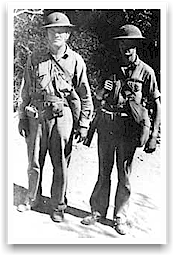
LtCol Curtis T. Beecher and his runner pause during one of his daily
inspections of 1st Battalion defenses.
Department of Defense Photo (USMC) 58735

Col Samuel L. Howard, right, inspects the beach defenses on
Corregidor with LtCol Herman R. Anderson, left, commander of 2d
Battalion, 4th Marines, and MajGen George F. Moore, USA, center,
overall commander of the Corregidor defenses.
Department of Defense Photo (USMC)
Phi-9
|
The enemy bombing and shelling continued with unrelenting ferocity.
Japanese aircraft flew 614 missions from 28 April until 5 May dropping
1,701 bombs totaling 365.3 tons of explosive. At the same time 9 240mm
howitzers, 34 149mm howitzers, and 32 other artillery pieces pounded
Corregidor day and night. Most of the Japanese artillery was based on
Bataan with one reinforced battalion firing from Cavite Province.
On 2 May, a 240mm
shell exploded the magazines of Battery Geary, causing massive
casualties to the Army crews manning the guns. A Marine rescue party ran
to assist in clearing the casualties from the resulting fires. Major
Francis H. Williams and Captain Austin C. Shofner were the first two
Marines into the battery and both were seriously burned about the hands,
face, and ankles in rescuing survivors from the blaze. Both officers
refused to be evacuated.
On 29 April the
61st Infantry Regiment of the 4th Imperial Japanese Army Division
was selected to be the first force to be landed on Corregidor.
Supporting the infantry were elements of the 23d Independent Engineer
Battalion and the 1st Battalion of the 4th Engineer
Regiment. Once on shore, elements of the 1st Company, Independent
Mortar Battalion, the 51st Mountain Gun Regiment, and the
3d Mortar Battalion would provide gunfire support.
The 61st Infantry
and attached units, titled Left Flank Force, was to land on the
tail of Corregidor on the evening of 5 May This 2,400-man landing force
would seize Kindley Field and then capture Malinta Hill. The following
night a second reinforced regiment of the 4th Infantry Division
would land on Morrison and Battery Points. The two forces would then
join for the capture of Topside.
Intelligence
On the evening of 4
May a Philippine civilian arrived in a small fishing boat on the beach
at Corregidor. The civilian carried a message from Philippine
intelligence on Bataan, and was promptly carried to Lieutenant Colonel
George D. Hamilton, the regimental intelligence officer. Hamilton called
for Sergeant Harold S. Dennis of the intelligence section to read the
note aloud, as he was having difficulty disciphering the message. Dennis
read, "Expect enemy landing on the night of 5/6 May." Hamilton quieted
Dennis, saying, "Hush, hush, hush, don't say another word! Do you want
to start a panic?" Hamilton took Dennis with the note to Colonel Howard
who listened as the note was read aloud a second time. In the morning of
5 May Howard called a meeting of all the regiment's senior officers.
Once assembled, Howard told them the contents of the note from Bataan.
The Japanese were expected to make their attack that night or the
following day.
There followed a
discussion of the probabilities of the landing. If the Japanese were
expected that night, the beach positions would be 100% manned at
nightfall. If the landing took place at dawn, the positions would be 50%
manned until dawn so the men could eat and rest for the coming attack.
Curtis asked the assembled officers for their opinions, which was
followed by a spirited discussion. Curtis then called for a vote, which
was unanimous for the men to sleep until one hour before dawn and then
fully man the defenses.
Colonel Howard then
spoke and asked for the opinion of Sergeant Dennis, the only enlisted
man in the room. Dennis had studied Japanese tactics in China and said
that enemy landings were invariably made at night, one hour before the
full light of the moon. Colonel Howard thanked him for his opinion, but
did not change the regiment's orders. The men would be allowed to sleep
for a predawn landing.
Major Max W.
Schaeffer commanded the regimental reserve, which consisted of two
companies lettered O and P, formed mainly from Headquarters and Service
Company's personnel. Schaeffer's would be the first unit to move to any
Japanese landing on Corregidor. At 1700, 5 May he made his final
preparation for the night. Major Schaeffer summoned Sergeant Gerald A.
Turner to his headquarters. The sergeant reported by asking "Well,
Major, what's the trouble now?" Major Schaeffer replied, "It may be a
long, long night for you. The reason I've called you down here is
because we need a 2d platoon, and you're it." He made Turner a
lieutenant and gave him command of 30-35 Filipino army officer cadets
formed into a platoon of three squads. "Don't go out and try to be a
hero," cautioned Schaeffer, "I want you to look after these kids and
take care of them." Even with the addition of Turner's platoon, the
regimental reserve numbered less than 500 men.
|
|
|
The Landing |
|

A Japanese artillery piece on Bataan pounds Corregidor, April 1942.
Photo
courtesy of Dr. Diosdado M. Yap
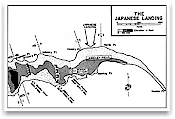
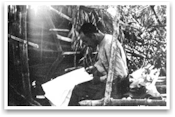
Col Gempachi Sato, who commanded the Japanese forces which
landed on Corregidor on 6 May, is here planning that invasion.
Photograph courtesy of 61st Infantry Association
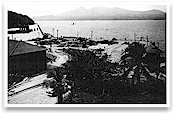
Bataan Peninsula is viewed across Manila Bay from the North Dock
area on Corregidor. The masts and stack of a ship sunk in the
bay are visible in the middle of the photograph.
Department of Defense Photo (USMC) 311-T
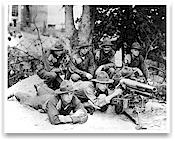
SSgt William A. Dudley physically lifted the trails of his 37mm
gun to fire down at the Japanese landing craft on the night of
5-6 May 1942. Dudley is the Marine second from the left in the
second row.
William C. Koch Papers, Personal Papers Collection, MCHC
|
At nightfall on 5 May
Colonel Gempachi Sato assembled his Left Flank Force at Limay on
the Bataan Peninsula. The gathered troops "sang softly the high thin
haunting melody of 'Prayer in the Dawn,'" and then climbed into 19
landing craft for the assault. The landing craft varied in size, the
smallest carrying 30 men and the largest 170. More important, five tanks
of the 7th Tank Regiment were also embarked in two landing craft.
The landing craft and barges approached Corregidor in a three-line
formation with expected landfall at 2300, shortly before the rise of the
moon.
At 2240 the artillery
shelling concentrated on the north shore beach defenses in the 1st
Battalion sector. At 2300, supplies of food and water were just reaching
the beach positions when landing boats were reported offshore. A second
artillery concentration pounded the beach defenses for 6-7 minutes. The
shelling was particularly intense, ending with phosphorous shells. Three
to four minutes of silence followed the last shell when word reached
Beecher at battalion headquarters that seven Japanese landing craft were
nearing the beach. The initial Japanese landing of 790 men of the
reinforced 1st Battalion, 61st Infantry was headed for the
beaches from Infantry Point to North Point.
Captain Lewis H.
Pickup of Company A watched from his command post as the first force of
landing craft in echelon headed for his company's positions.
Searchlights picked up the landing craft and the 1st Battalion commenced
firing. The 37mm guns had no trouble tracking the landing craft, as
Sergeant Louis E. Duncan had altered the traversing mechanism so it
could move more freely Gunnery Sergeant William A. Dudley held up the
trails to his 37mm gun to fire down on the incoming boats.
Private First Class
Silas K. Barnes heard the boat motors from his machine gun position on
Infantry Point and for a few moments was able to hit the approaching
landing craft that were illuminated by the search lights. He effectively
enfiladed Cavalry Beach and cut down many of the Japanese soldiers as
they came ashore. The Japanese struggled in the layers of oil that
covered the beaches from ships sunk earlier in the siege and experienced
great difficulty in landing personnel and equipment. Unfortunately
Barnes' and one other machine gun position were all that remained of 13
machine guns from Infantry Point to North Point. The rest had been
destroyed by the Japanese bombardment.
The 1st Platoon,
Company A, commanded by First Lieutenant William F. Harris, defended the
beach from Infantry to Cavalry Points, while the 2d Platoon under Master
Gunnery Sergeant John Mercurio held the line from Cavalry to North
Points. "I've got word that landing boats will attempt a landing,"
Harris told his men, "They'll be coming in here someplace. Fix
Bayonets." He ordered Private First Class James D. Nixon to go to the
cliff overlooking the beach, and report on the location of the Japanese.
Nixon looked at the beach and saw Japanese troops coming ashore only 30
feet away. The Marines placed a heavy fire on the Japanese as they
climbed the steep cliffs and tossed "Molotov Cocktails" down on the
landing craft. In the darkness, however, the Japanese succeeded in
bypassing many of the Marine positions.
Master Gunnery
Sergeant Mercurio's 2d Platoon was spread thin covering the beach area,
with many of his positions right on the water. "At high tide," recalled
Corporal Edwin R. Franklin, "I could reach out and touch the water." The
landing craft were only 100 yards away from the beach when Japanese
flares lit up the night. The 2d Platoon began firing, but the Japanese
were too close to halt the landing. A landing craft beached in front of
Franklin's position and enemy troops began coming ashore. Mercurio,
armed with only a pistol, killed a Japanese soldier "so close he could
have touched him," as the Japanese overran the beach defenses. The
fighting became particularly bloody, "with every man for himself,"
remembered Franklin. The Japanese 50mm heavy grenade dischargers or
"knee mortars" were particularly effective at close range, and the
overwhelming numbers of Japanese infantry forced Mercurio's men to pull
back from the beach.
Corporal Joseph Q.
Johnson, a 31st Infantry soldier attached to the 2d Platoon, remembered,
"the gun next to me chattered, and glancing to my right, I saw its
targets, small, fleeting, darting in the shadows." Johnson fired two
belts of machine gun ammunition and was firing a third one when a
grenade landed 20 yards away. A second grenade landed closer, and rifle
fire also hit Johnson's position. When a third grenade landed only 10
yards from the gunpit, Johnson ran to the next machine gun position and
found the two occupants dead. He kept moving, crawling along the beach
with two other survivors of his platoon, toward Kindley Field.
The survivors of the
2d Platoon found themselves surrounded by the advancing Japanese as they
tried to reach safety Corporal Franklin saw a grenade land in the trail
in front of him, which exploded and knocked him to the ground with a
head wound. Franklin next hazily saw a Japanese soldier charging with
fixed bayonet. The Marine said to himself, "I ain't going this f*****
way" and jumped up to engage the enemy with his own bayonet. Franklin
was stabbed in the chest, but succeeded in killing the Japanese soldier.
He ran ahead down the trail past another enemy soldier, who shot
Franklin in the leg, but the Marine continued moving until he reached
Malinta Tunnel.
Lieutenant Harris was
forced to pull his platoon out of the area of Cavalry Point after the
Japanese overran Mercurio's platoon. Most of the men fought on their own
through the night. Private First Class Nixon moved toward the high
ground of Denver Battery, when he encountered a Japanese soldier,
"eyeball to eyeball." Both men charged with fixed bayonet, and in the
ensuing struggle, Nixon was able to wound the Japanese soldier in the
side. He left his enemy in the darkness and moved toward the sound of
firing.
After facing 30-45
minutes of defensive firing the landing craft seemed to abandon their
attempts to land and retired to the bay. The firing then subsided.
Unknown to Captain Pickup, most of the 1st Battalion, 61st Infantry
was ashore in 15 minutes and the barges were returning to Limay. The
Japanese sent up a flare to signal a successful landing at 2315. In 30
minutes, Colonel Sato had his men off the beach and moving inland.
The 785 men of the
reinforced 2d Battalion, 61st Infantry were not so successful.
The Japanese planners had not reckoned with the strong current in the
channel between Bataan and Corregidor and the battalion landed east of
North Point where all defensive positions were still intact. The craft
also hit the Corregidor beach 10 minutes after the 1st Battalion,
and the Marines were ready and alert for the attack. The Japanese came
under heavy fire for the next 35 minutes, losing eight of 10 landing
craft on the shore and one more sinking after pulling off the beach.
Private First Class
Roy E. Hays manned a .30-caliber machine gun nestled in the cliffs
overlooking the beach area at Hooker Point. He could see the barges
approach his position, but was ordered to hold fire until the landing
craft came closer. Hays decided, "We're not waiting any longer," and
opened a devastating fire at point blank range. This was instantly
followed by accompanying fires from all the weapons positions along the
beach.
The Japanese who did
get ashore were crowded in most cases on beaches that were only 30 feet
wide backed by 30-foot-high cliffs. Most of the officers were killed
early in the landing, and the huddled survivors were hit with hand
grenades, and machine gun and rifle fire.
Private First Class
David L. Johnson remembered a sailor named Hamilton firing a twin
.50-caliber machine gun up and down the beach, "like shooting ducks in a
rain barrel. The Japanese would run up and down the beach," remembered
Johnson "and each time there would be less men in the charges. Finally
they swam into the surf, and hid behind boulders." For the remainder of
the night, only small bands of Japanese were able to scale the cliffs
and engage the Marines.
Captain Pickup went
out to check his platoons, assuming the attack had been repulsed. He
then learned that some of the landing craft had made it ashore in the
North Point area and Japanese troops were moving inland. At the same
time, Beecher sent runners to all of his company commanders alerting
them to the landing. As planned, if the enemy penetration was
successful, Company A would withdraw and join Company B in a line based
on Battery Denver, holding the tail of the island from the Japanese.
Before the line could be formed, the Japanese captured Denver at 2350
and were discovered digging in. Colonel Sato had led his 1st
Battalion soldiers to Denver Hill almost unnoticed.
|
|
|
Counterattack |
|
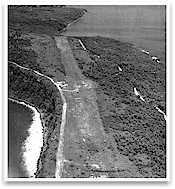
A postwar view of the Cavalry and Infantry and Point landing
beaches on Corregidor and Kindley Field. Note the Denver Battery
ridge on the left of the photograph.
National Archives

Barbed wire entanglements on the beach at Corregidor. Most of
these were destroyed at the time of the Japanese landing. |
Platoon Sergeant William Haynes led his 3d Platoon, the reserve platoon
from Company B, from the south beaches at Monkey Point over to reinforce
Company A. Haynes kept his men together in the darkness and reached the
beach area. Hearing Japanese voices ashore, the platoon moved and fired
trying to make contact with the Japanese, but they were firing only at
the voices. After an hour the platoon became scattered in the darkness
and each Marine fought the rest of the night on his own.
Captain Pickup had
only just returned to his headquarters, when he discovered the enemy on
Denver. His first reaction was to pull a platoon off the beach and
retake the battery but in discussion with First Lieutenant William
Harris, he decided to keep his beach defenses intact and await
reinforcements. Marine Gunner Harold M. Ferrell went to 1st Battalion
headquarters to alert Captain Noel O. Castle, commanding Company D, to
the Japanese landing. He had sent a runner to Denver Battery where he
found Japanese in the gun pits. Castle, a distinguished marks man and
pistol shot who carried two pearl-handled .45-caliber pistols, assembled
the Marines of Headquarters Company and the few Marines available of
Company D to drive the Japanese off of Denver Hill.
Castle dispatched
Sergeant Matthew Monk with 15 drivers and cooks to occupy an abandoned
beach defense position and secure his left flank. "Do the best you can,"
he ordered Monk, "Keep the Japanese out of the tunnel." Castle also
scouted the reserve stations at critical road junctions, and cautioned
the men, "Maintain positions." He then gathered his men for the counter
attack to Denver Battery, declaring, "Let's go up there and run the
bastards off."
Ferrell warned Castle
from leading the attack himself, but the captain replied, "I'm going to
take these people up there and shoot those people's eyes out" and led
his men to the hill. Castle met the Marines falling back from the
Japanese advance, and joined in the battle. At 0140, the Japanese
attacked the water tower and ran directly into the reinforced platoon
led by Castle. The two forces collided in furious combat, practically
"face to face," remembered Corporal Joseph J. Kopacz. The Japanese
advance was halted but the Marine attack was bloodily repulsed.
Castle left the
battle line and ran to an abandoned .30-caliber machine gun, which he
put into working order, while "completely covered by enemy fire." Castle
opened a devastating fire with the machine gun, forcing the Japanese to
cover, which allowed the American advance to continue. The Japanese fell
back from the water tanks to the Denver Battery positions, but Castle
was hit by Japanese machine gun fire and killed. With their commander
down, the attack ground to a halt.
Captain Golland L.
Clark of Headquarters Company, 1st Battalion, then ordered mortar fire
placed on the ridge and for 20 minutes Stokes mortars, converted to fire
81mm ammunition, pounded the Japanese positions. However, the Marine
with the range card which contained the coordinates which targeted the
entire end of the island could not be found throughout the night. The
mortar firing soon halted as stray rounds were impacting on Marine
positions on the other side of the hill. For the moment only scattered
Marines from every company in the 1st Battalion held the Japanese from
moving on to Malinta Tunnel.
Gunner Ferrell put
together what few men he could find from Company D and formed a line to
prevent the Japanese from moving down from the high ground and taking
the northern beach defenses from the rear. Marines from Headquarters
Platoon, Company A, joined the battle on their own. First Sergeant Noble
J. Wells formed 25 to 30 Marines on line to prevent the Japanese from
moving along the north road. The Japanese soon attacked, screaming,
"Banzai! Banzai!" and reached within 15 to 20 yards of the Marine
position before being turned back. The Japanese then tried to infiltrate
behind Wells' men. He posted two Marines to guard the communication
trench. Corporal Howard A. Jordan heard a noise and shouted, "Who goes
there?" A voice responded, "Me Filipino, got hurt foot," and a figure
began to run. Both Marines opened fire, and dropped the man who turned
out to be a Japanese soldier. Corporal John H. Frazier later remarked,
"Didn't have to worry about that foot anymore."
Before midnight,
Lieutenant Colonel Beecher committed his battalion reserve, a platoon of
30 Philippine Scouts, but the Japanese were obviously firmly ashore and
more reinforcements were needed to drive the enemy back to the beaches.
Lieutenant Colonel Samuel V. Freeny organized a platoon of men, gathered
from Malinta Tunnel, to reinforce the beleaguered 1st Battalion. One of
the U.S. Army enlisted men complained, "I've never fired a rifle before,
I'm in the finance department." Freeny replied, "You just go out and
draw their fire and the Marines will pick them off." With the 1st
Battalion fully committed, Colonel Howard ordered the regimental reserve
under Major Max Schaeffer to report to Beecher. The 4th Battalion was
alerted to be ready to respond should more men be needed.
|
|
|
Movement of the Regimental Reserve |
|

The landing area from Cavalry to Infantry Points, Corregidor.
Photograph courtesy of 61st Infantry Association

A view of the 4th Marines beach defenses, at this point
consisting of sandbagged bunkers and trenches. Note that the
Japanese bombardment has taken every leaf from nearby trees.
Department of Defense Photo (USMC) OOR-11004
|
At the sound of machine gun fire, Major Schaeffer alerted his two
companies which formed the regimental reserve, and sent Sergeant
Turner's Filipino cadet platoon in advance to Malinta Tunnel. Shortly
before midnight, he moved the rest of his men to the tunnel. The Marines
pulled on their bandoliers of ammunition, fastened grenades to their
cartridge belts, and as Private First Class Melvin Sheya remembered,
said to each other, "Well, here goes nothing." The two companies moved
along the South Shore Road under Japanese artillery fire, but lost only
a few men before reaching the tunnel.
When Sergeant
Turner's platoon reached Malinta Tunnel, he found the passage blocked by
hundreds of "tunnel rats," soldiers who had no organization on the
island and lived in the safety of the tunnel. These men wouldn't clear
the corridor for the regimental reserve to pass into. Turner ordered his
men, "Fix bayonets, boys, let's give them a nudge." The main passage of
the tunnel was soon cleared.
Lieutenant Colonel
Beecher informed Schaeffer of the situation on Denver Hill as the
Marines drew more hand grenades and Lewis machine gun magazines from
caches planted against an eastern attack. All proceeded according to
plan. A few Marines and sailors from the tunnel joined the column as
ammunition bearers. At 0100 Major Schaeffer gave his company and platoon
commanders orders to counterattack and drive the Japanese off the tail
of Corregidor. Company P would advance down the road toward Kindley
Field and upon meeting resistance would deploy to the left of the road
while Company O would move to the right. Together the companies would
sweep to the end of the island. Officers of the 1st Battalion would lead
the two companies into position.
At 0200 the two
companies of the regimental reserve deployed down the road leading east
from Malinta Tunnel. Sergeant Turner's platoon again led the advance
from the tunnel, literally running into Captain Golland L. Clark, 1st
Battalion adjutant, who was directing reinforcements to the battle area.
"Oh, Turner, what's your unit?" Clark asked. "It's my platoon. They sent
me out here and I'm supposed to contact you," answered Turner. "I want
you to go down this road," Clark ordered, "just keep going as far as you
can until you make contact with D Company."
Sergeant Turner's
platoon moved less than 200 yards when a green flare went up right above
the men. Turner stopped, turned, and called out, "Hit the deck," as
Japanese artillery began raking the area. The platoon went to ground and
was prevented from going to the Denver Battery fight. Rifle fire also
ranged into the position and continued to pin the platoon down.
Major Schaeffer's
main force followed behind Turner. Shots were soon exchanged between
Marines of the two companies. Cloaked in darkness it was impossible to
tell friend from foe. At a fork in the road, Company P turned left and
Company O took a right turn. First Lieutenant Hogaboom, commanding
Company P, soon ran into scattered Japanese fire and Captain Clark
ordered Hogaboom to deploy his men into line formation. Hogaboom soon
found that he had only his 2d Platoon. The other two platoons were
nowhere to be seen.
Company O, behind
Company P, had almost reached the fork in the road when they began to
take Japanese rifle and machine gun fire. Sergeant Carl M. Holloway
remembered, "we had been so accustomed to . . . heavy artillery fire and
bombs for so many months, that the bullets kicking up dust around our
feet seemed at times almost like rain drops hitting the dust." Flares
then lit up the night sky followed by a thunderous Japanese barrage. The
lead platoon was able to take cover in nearby bomb craters but still
lost eight men in the first few minutes of the shelling. The rest of the
company was caught in the open and cut to pieces. The 3d Platoon was
left with only six Marines unhurt while 2d Platoon had only five.
As soon as the
barrage lifted, Quartermaster Clerk Frank W. Ferguson advanced his 1st
platoon as ordered but came under heavy machine gun fire from Battery
Denver hill. Ferguson deployed his platoon to the left of the road and
tried to tie in with Company P. He believed that the two platoons behind
him would soon be up to anchor his right to the beach and to support his
advance. A few isolated Marines did reach him, but only a handful.
Ferguson then led his men up the hill into the face of concentrated
machine gun fire. The commitment of the regimental reserve was now
whittled down to two isolated platoons, each advancing unsupported.
At 0300 Ferguson's
platoon came to a halt on the hillside. The steep slopes were covered by
interlocking machine gun fire and despite three attempts, only a few
yards were gained. The 1st Platoon halted only 30 yards from the
Japanese positions and dug in. The battle now raged around the two
concrete water tanks on top of the ridge, just ahead of the Denver
Battery position. Ferguson's immediate concern was for his flanks and he
moved a Lewis gun and an automatic rifle to cover the road to his right.
His left still had no connection with Company P, but Quartermaster
Sergeant John E. Haskin brought up his five men of 3d Platoon and
Ferguson sent them to the left to extend that flank. Captain Chambers
ordered the five survivors of the 2d Platoon to Ferguson who also sent
them to his left. Soon word reached Chambers that Company P had been
joined.
While Ferguson was
battling for the hill, Lieutenant Hogaboom as advancing along the
coastal road toward the Japanese landing areas. He met a platoon of
Marines of Company A under Lieutenant Harris engaged in sweeping out
Japanese snipers from a wooded area. Harris agreed to support Hogaboom,
extending Hogaboom's left to the beach. Luckily, Hogaboom's 1st Platoon
found its way to the front and was placed in reserve. The three platoons
advanced, killing a few scattered Japanese soldiers until they hit the
Japanese main defense line in the draw extending from Battery Denver to
the northern beaches. Hogaboom's men were stalled by the Japanese fire
and even the 1st Platoon could deploy no further.
With no reserve and a
tenuous right flank, Hogaboom was forced to draw a squad to the right
rear. As he was deploying the Marines, Japanese landing barges appeared
from the sea bearing for the beaches on Hogaboom's left. The 1st
Battalion Marines on North Point opened on the barges spraying them with
.50-caliber machine gun fire. "The bullets smacking the armor of the
barges sounded like rivet hammers rattling away," remembered Hogaboom.
Private First Class Robert P. McKechnie took a Lewis gun to an overlook
and personally disabled two of the barges, leaving them drifting
aimlessly.
After savaging the
attempted landing, the Marines tried to advance to join the members of
the 1st Battalion at Cavalry Point, but the Japanese machine gun at the
head of the draw proved to be too well protected. The remnants of both
companies settled in their positions and then began a duel of American
grenades against the ammunition of the deadly accurate Japanese "knee"
mortars. Captain Robert Chambers, Jr., met with Hogaboom before dawn to
coordinate the battle line of the two companies. Both commanders agreed
that without reinforcements, the battle would soon go against the
Marines.
|
|

Capt Noel O. Castle, expert team shot with both rifle and pistol, was
killed leading the first counterattack on Denver Hill. He is shown here
at the Camp Perry matches in March 1937, when he was a member of the
Marine Corps rifle team. Department of
Defense Photo (USMC) 7563 |
Before midnight, Colonel Howard gave orders for the 4th
Battalion to prepare to move to Malinta Tunnel and replace the regimental
reserve. Major Williams had already alerted his men based on the view he had
of the east end of the island. The men of the battalion needed little
warning, having also watched the landing take place. At midnight Williams
had extra ammunition issued and all companies ready to move. At 0130 he
received Howard's order to shift to the tunnel and the 4th Battalion moved
at once.
The battalion marched in the darkness in two columns
along the road to the tunnel well spread out to avoid Japanese artillery
fire, but were delayed by a 20-minute artillery barrage and suffered a few
casualties. By 0230, Major Williams had his men into Malinta Tunnel and
awaited further orders.
At 0430 Colonel Howard decided to commit his last
reserves, the 500 Marines, sailors, and soldiers of the 4th Battalion. Major
Williams' men were long ago ready to move out, the Malinta Tunnel being
severely congested with a constant stream of wounded Marines from the early
fighting. Morale in the battalion was strained by the constant concussions
from the Japanese shelling outside and the proliferation of rumors in the
tunnel. Lieutenant Charles R. Brook, USN, remembered, "It was hot, terribly
hot, and the ventilation was so bad that we could hardly breathe."
Led by Major Williams, the battalion emerged from the
tunnel in platoon column. The men were suddenly subjected to a severe
shelling and casualties began to mount before the last company was able to
leave the tunnel. However, within 10 minutes, the battalion reformed under
fire and began to move forward. Another barrage soon struck, causing more
casualties and confusion. Minutes later, the column was again reorganized
and the advance continued. At 200 yards behind the line of the 1st
Battalion, Williams ordered Companies Q and R to deploy in a skirmish line
and guide to the left of the line. Company T repeated the orders and formed
on the right of Company R and guided to the right. Company S formed the
reserve.
The order of the battalion was prudent, for the main line
of resistance was badly in need of reinforcement. In the moonlight,
deployment into skirmish formation was difficult, but eventually
accomplished. Contact with the 1st Battalion was spotty at best and no
Marines were found in line ahead of Company R. Scattered parties of Japanese
soldiers had infiltrated behind the Marine positions all night and their
sniping proved worrisome to the inexperienced sailors. Both Companies Q and
R were receiving fire from ahead and behind as they moved into position.
In the confusion, two sailors, Signalman First Class
Maurice C. Havey and Signalman First Class Frank H. Bigelow, became
separated from their command and came upon an unmanned twin .50-caliber
machine gun overlooking the beach area. They manned the gun and opened fire
on the Japanese on the coastline for 30 minutes. Havey fired until the
barrels burned out and Bigelow then replaced them. Suddenly, Havey dropped
from the gun, turned and said, "I'm hit." He staggered to the rear toward
Malinta Tunnel while Bigelow stayed with the gun. Havey had travelled only
100 yards when he was killed by seven machine gun bullets across the chest.
|
|

A prewar view of Denver Hill from Malinta Hill. Note the water tank on
the hill.
National Archives

Japanese soldiers pause
amid the fighting on 6 May as they move their light artillery inland from
the beaches. Photograph
courtesy from 61st Infantry Association
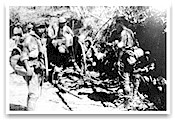
Japanese troops move to the high ground on Corregidor's north shore
during the firefighting on 6 May.
Photograph courtesy of 61st Infantry
Association
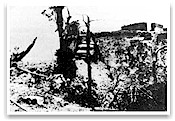
These two water tanks were the focus of the heaviest 4th Marines
fighting on 6 May. The tank in the foreground overlooked the Denver
Battery positions and was where QMSgt John E. Haskin and SgtMaj Thomas
F. Sweeney died.
Photo courtesy of
61st Infantry Association
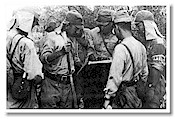
Col Sato confers with his staff during the fighting for Denver Battery
hill. The absence of an ammunition resupply threatened the success of
his landing.
Photograph courtesy of 61st Infantry Association
|
Attack
of the 4th Battalion |
|
Unbeknownst to the Marines, the Japanese troops on
Corregidor received reinforcements just before dawn. The 3d Battalion,
61st Infantry, engineers, and light artillery arrived with at least 880
men to join the battle. This force was originally scheduled to arrive at
0230, but the losses in landing craft in the initial attack forced the
delay. Even so, five tanks and most of the field artillery were left on
Bataan due to lack of landing craft. At 0530, three green flares signaled
the successful landing by the Japanese.
From 0530 to 0600 the four company commanders of the 4th
Battalion tried to put their men into position but were hampered by the
darkness, lack of knowledge of the terrain, and the lack of cohesion of the
1st Battalion. In some cases the 4th Battalion actually formed a line behind
the 1st Battalion positions with no knowledge of the Marines ahead of them.
Luckily, the Japanese artillery was strangely silent. Major Schaeffer came
out of the firing line to confer with Major Williams on the placement of the
reinforcements, asking, "Joe, what in the hell did you bring me?" Williams
responded, "I have my whole battalion here — or what's left of them. Where
is your unit? and what position do you want my battalion in?" Schaeffer lost
his composure for a moment and replied, "Joe, I don't know! . . . I don't
know where in hell my non coms are, I think they are all dead!" Williams
motioned a near by corpsman to check the major and said, "Dammit now, you
relax, I'll take over this situation." Schaeffer pulled himself together and
indicated the most needy area was the gap between his two companies. Company
S moved out of reserve and forward to fill the breach.
Major Williams and his staff armed themselves with rifles
and hand grenades and entered the front lines where the firing was the
heaviest. This command decision at times prevented tight coordination among
the companies as the commanders often would have little idea how to contact
the major. The dazed battalion settled into its positions and extended its
flanks to cover the island from end to end. A decision was reached to find
how many men had been lost in getting into position, but this effort was
unsuccessful. The best estimate of the strength of the battalion at that
time was about 400 men.
At 0600 Williams ordered his battalion to counterattack
at 0615, the break of dawn. In 10 minutes all companies were alerted and
jumped off promptly at the designated time. The order, "Charge," came down
the line and the Marines, sailors, and soldiers attacked with fixed
bayonets, "yelling and screaming . . . cursing and howling . . ." Gunner
Ferrell tried to use the 1st Battalion Stokes mortars to support the attack,
but again the rounds were too inaccurate for use. Companies Q and R rapidly
gained ground on the left, but Company S ran at once into heavy machine gun
fire and was halted after moving only 100 yards.
Company T also ground to a halt after gaining little
ground. The Japanese sent up flares which brought a prompt response from the
artillery on Bataan. In 10 minutes the gunfire halted and Company T resumed
the attack on the ground around Battery Denver, but machine gun fire quickly
halted the advance. A machine gun position on the north road was knocked
out, as was another in the ruins on Battery Denver Hill, but at heavy cost.
Major Schaeffer was pinned down in his command post by
these two machine guns and had lost contact with his men. When the fire was
silenced, he rose from his position, a mixture of dirt and blood from wounds
running into his eyes, blinding him. Despite his wounds, Schaeffer tried to
reorganize his men and explain to Williams what had happened. Major Williams
had Schaeffer cared for and calmly took control of the action.
Predictably, contact was soon lost between the two left
companies, Q and R, and the two companies on the right, S and T. The
companies on the left had outdistanced those on the right by 200 yards.
Williams halted Companies Q and R, ordering them to regain contact with the
stalled companies and try to break into the Japanese flank on Denver. The
two boat loads of Japanese soldiers left drifting by Private First Class
McKechnie, and now hung up off shore, were successfully destroyed despite
the poor marksmanship of the sailors in Company Q. At 0630 Williams began to
shift men to the right, which was hard-pressed.
Quartermaster Clerk Ferguson, now in command of Company
O, decided to attack the two machine guns which covered the beach road by
the flank. Ferguson, with six men, moved down the road covered for some
distance by the road embankment. Unfortunately, two new machine guns opened
on the party and they were bracketed by knee mortars. By the time Ferguson
was abreast of the first guns he had only one man left, Corporal Alvin E.
Stewart of the 803d Engineer Battalion. The two gave up the enterprise and
moved to the south side of the road to place rifle fire on the offending
machine guns.
The Japanese on top of the hill evidently thought they
were being flanked by a larger party of men and a reinforced platoon began
to file out of Battery Denver to counter Ferguson's move. The Japanese were
entirely in silhouette against the skyline and the two Americans by the road
had perfect targets. Ferguson later wrote "There wasn't a chance to miss
them — we were too close for that." Within seconds 20 Japanese soldiers were
killed or wounded. The Americans were so intent on firing that they didn't
notice a Japanese rifleman coming up behind them. Ferguson was shot by a
glancing bullet in the face, leaving blood streaming from his nose and
cheek. Stewart was able to pull him back to the Marine battle line without
further wounds.
One of the major impediments to the Marine attack was a
Japanese machine gun placed in a hole in the base of one of the water tanks.
Quartermaster Sergeant John E. Haskin and Sergeant Major Thomas F. Sweeney
ran under fire and climbed up the cement water tower in the predawn
darkness. The two Marines did not expect to survive the battle, and their
comrades knew that both would attempt some extreme action during the
expected fighting. Marine Gunner Ferrell talked to Sweeney as he led his men
into action that morning. Sweeney said as they parted, "Well, this is it.
We've been in the Marine Corps for 15 years and this is what we've been
waiting for. If I don't see you, that's the way it is."
The two Marines now lobbed grenades into the Japanese
positions, promptly destroying the machine gun in the water tank. Captain
Brook remembered, "A Marine sergeant . . . gathered an armful of hand
grenades and climbed to the top of a stone water tower near our front line.
From here, he threw them at a Japanese sniper position and succeeded in
knocking it out." Another Marine, Corporal Sidney E. Funk, was crawling
beside the water tank when he heard a voice call down, "Hey Funk, those
bastards are right over there in the brush. If I had enough hand grenades,
I'd blow the hell out of them." Funk had no idea who the voice belonged to
and quickly crawled away for cover.
Despite drawing fire to themselves, Haskin and Sweeney
continued to have some initial success, destroying at least one more machine
gun. However, their supply of grenades was soon exhausted and Haskin was
killed while reclimbing the tower with more ammunition. Sweeney was killed
soon after. The two "were very close friends in life," remembered
Quartermaster Clerk Frank W. Ferguson, "it was most fitting that they should
go out together."
The American advance on both the right and the left was
next halted by an enemy machine gun located in the gun pit of Battery Denver
near the water tower. From this commanding position the gun could hit any
movement from the north coast to the south. The gun drew the attention of
Major Williams who personally took on the gun with his Springfield rifle
with no result. At 0730 Lieutenant Bethel B. Otter, USN, commanding Company
T, took Ensign William R. Lloyd and four volunteers, armed only with hand
grenades, to take out the gun.
Under covering fire of the company, Otter crawled with
his volunteers to within 25 yards of the gun pit and lobbed grenades into
the position. For a few moments the weapon was silent, the gun crew dead.
Almost immediately the gun crew was replaced and all but one member of the
assault party was killed. With the gun still in operation, no movement
further east could be accomplished. Army Captain Calvin E. Chunn of the
battalion staff took over the company and led an advance on a group of
Japanese soldiers setting up a light artillery piece. As the company moved
forward, a shell struck amidst the command group, wounding Chunn and two
other officers. By 0900 the 4th Battalion was stalled and Williams sent to
Colonel Howard for reinforcements and artillery support to resume the
attack. Neither were available.
First Lieutenant Mason F. Chronister of Company B, on the
south shore beaches, could see in the growing daylight the Japanese holding
the high ground around Denver Battery. He organized his platoon with
volunteers from the Navy Communications Tunnel and Battery M, 60th Coast
Artillery, to attack the Japanese from the west at the same time Williams
was attacking from the east. The attack proceeded up the ridge, but hit
Japanese reinforcements from the recently landed 3d Battalion, 61st
Infantry, also moving up the hill. Lieutenant Chronister withdrew his
men from the larger force, and moved them along a trail, joining Williams'
line at the watertank.
|
|
|
Morning Battle |
|
|
During the morning action Major Williams fought beside his
men, moving from position to position along the line. Captain Brook remembered,
"He was everywhere along the line, organizing and directing our attack, always
in the thick of it, seeming to bear a charmed life. I have heard men say that he
was the bravest man they ever saw."
From 0900 until 1030 the fire fight proceeded without change
in position. The lines were so close that none of the companies could shift a
squad without drawing machine gun fire and artillery. All of the 4th Battalion
was fighting without helmets, canteens, or even cartridge belts. However, the
Marines had the advantage of being too close for the Japanese artillery to be of
use. Small parties of Marines occasionally were dispatched to take out Japanese
snipers who were firing into the rear of the Marine position from the beach
area.
The Japanese were now facing a serious problem, which
threatened to lose the battle for them. Each Japanese rifleman came ashore with
120 rounds of ammunition and two hand grenades. The machine gun sections carried
only two cases totalling 720 rounds of ammunition and three to six grenades. The
knee mortar sections had only 36 heavy grenades and three light grenades. A
large quantity of additional ammunition had been loaded on the landing craft due
to the expect ed problems in resupplying the force. However, the ammunition
crates had been hurriedly dumped overboard by the crews of the landing craft as
they grounded on Corregidor and now few boxes could be recovered in the murky
water. By morning most of the Japanese on Denver Hill were either out of
ammunition or very close to it. Many Japanese soldiers were now fighting with
the bayonet and even threw rocks at the Marines to hold the hill.
At 0900, Captain Herman Hauck, USA, reinforced the Marines
and sailors with 60 members of his Coast Artillery battery Williams placed the
soldiers on the beaches to his left where heavy losses had whittled away at his
strength. With the reinforcements some advance was made, but against strong
enemy resistance. Nevertheless, much of the fighting was done with the bayonet,
as the Japanese were running out of ammunition. The tide was beginning to turn
against the Japanese. As Lieutenant General Masaharu Homma reflected one year
after the surrender, "If the enemy had stood their ground 12 hours longer,
events might not have transpired as smoothly as they did."
The Japanese were able to set up a mortar battery on North
Point and opened with telling effect on Williams' left companies. Two squads
were sent out to flank the guns, but ran into machine gun fire which wiped out
almost the entire right squad. Three more squads were sent out, two to the left
and one to the right of the mortars. After heavy fighting and loss, the deadly
mortars were silenced.
The machine gun at the head of the draw at Cavalry Point also
had held up the progress of the advance. U.S. Army Lieutenant Otis E. Saalman of
the 4th Battalion staff was ordered by Williams to go to the left and see what
he could do to get the line moving. With the help of Captain Harold Dalness,
USA, Saalman took a party of volunteers up the draw to silence the gun. The
Americans crawled unobserved to within grenade range and then opened fire on the
enemy with rifles and grenades. One of the Japanese defenders picked up a
grenade and lifted it to throw it back at the Americans when it went off in his
hand. The gun was at last silenced and the way lay open to link up with the 1st
Battalion survivors to the east. Saalman was able to observe the Japanese
landing area where he watched three Japanese tanks climbing off the beach.
|
|
|
Tanks |
|

Japanese tanks and infantry on Corregidor after the surrender. Note the
captured U.S. M-3 tank on the left of the photograph.
Photograph courtesy
of Dr. Diosdado M. Yap
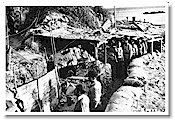
Beach defenses after the surrender of Corregidor. Note the captured
defenders standing in the trenchline.
National Archives
photograph |
The Japanese landed three tanks, two Type 97 tanks and a
captured M-3. Two other tanks were lost 50 yards offshore while landing with the
2d Battalion, 61st Infantry. The surviving tanks were stranded on the
beach due to the steep cliffs and beach debris and were left behind by the
advancing infantry. In one hour, the tank crews and engineers worked a path off
the beach. When the tanks reached the cliffs, they found the inclines too steep
and were unable to move further. The Marines were alerted to the presence of the
tanks and Gunner Ferrell went to Cavalry Point to investigate the rumors of
tanks, and found the vehicles apparently hopelessly stalled.
At daylight the Japanese were able to cut a road to Cavalry
Beach but were still prevented from moving inland by the slope behind the beach.
Finally the captured M-3 negotiated the cliff and succeeded in towing the
remaining tanks up the cliff. By 0830, all three tanks were on the coastal road
and moved cautiously inland. At 0900, Gunnery Sergeant Mercurio reported to
Malinta Tunnel the presence of enemy armor.
At 1000 Marines on the north beaches watched as the Japanese
began an attack with their tanks, which moved in concert with light artillery
support. Private First Class Silas K. Barnes fired on the tanks with his machine
gun to no effect. He watched helplessly as they began to take out the American
positions. He remembered the Japanese tanks' guns "looked like mirrors flashing
where they were going out and wiping out pockets of resistance where the Marines
were." The Marines still had nothing in operation heavier than automatic rifles
to deal with the enemy tanks. Word of the enemy armor caused initial panic, but
the remaining Marine, Navy and Army officers soon halted the confusion.
One of the Marines' main problems was the steady accumulation
of wounded men who could not be evacuated. Only four corps men were available to
help them. No one in the battalion had first aid packets, or even a tourniquet.
The walking wounded tried to get to the rear, but Japanese artillery prevented
any move to Malinta Tunnel. No one could be spared from the line to take the
wounded to the rear. At 1030 the pressure from the Japanese lines was too great
and men began to filter back from the firing line. Major Williams personally
tried to halt the men but to little avail. The tanks moved along the North Road
with Colonel Sato personally pointing out the Marine positions. The tanks fired
on Marine positions knocking them out one by one. At last Williams ordered his
men to withdraw to prepared positions just short of Malinta Hill.
With the withdrawal of the 4th and 1st Battalions, the
Japanese sent up a green flare as a signal to the Bataan artillery which
redoubled its fire, and all organization of the two battalions ceased. Men made
their way to the rear in small groups and began to fill the concrete trenches at
Malinta Hill. The Japanese guns swept the area from the hill to Battery Denver
and then back again several times. In 30 minutes only 150 men were left to hold
the line.
The Japanese had followed the retreat aggressively and were
within 300 yards of the line with tanks moving around the American right flank.
Lieutenant Colonel Beecher moved outside the tunnel, shepherding his men back to
Malinta hill. He knew his men would be thirsty and hungry and ordered Sergeant
Louis Duncan to "See what you can do about it." Duncan broke open the large Army
refrigerators near the entrance to Malinta Tunnel, and soon was issuing ice-cold
cans of peaches and buttermilk to the exhausted Marines.
At 1130 Major Williams returned to the tunnel and reported
directly to Colonel Howard that his men could hold no longer. He asked for
reinforcements and antitank weapons. Colonel Howard replied that General
Wainwright had decided to surrender at 1200. Wainwright agonized over his
decision and later wrote, "It was the terror vested in a tank that was the
deciding factor. I thought of the havoc that even one of these beasts could
wreak if it nosed into the tunnel." Williams was ordered to hold the Japanese
until noon when a surrender party arrived.
At 1200 the white flag came out of the tunnel and Williams
ordered his men to withdraw to the tunnel and turn in their weapons. The end had
come for the 4th Marines. Colonel Curtis ordered Captain Robert B. Moore to burn
the 4th Marines Regimental colors. Captain Moore took the colors in hand and
left the headquarters. On return, with tears in his eyes, he reported that the
burning had been carried out. Colonel Howard placed his face into his hands and
wept, saying, "My God, and I had to be the first Marine officer ever to
surrender a regiment."
The news of the surrender was particularly difficult for the
men of the 2d and 3d Battalions who were ready to repel any renewed Japanese
landing. Private First Class Ernest J. Bales first learned of the surrender when
a runner arrived at his gun position at James Ravine, who announced, "We're
throwing in the towel, destroy all guns." Bales and his comrades found the news
incredible, "hard to take ... couldn't believe it." One Marine tried to shoot
the messenger but was wrestled to the ground.
Private First Class Ben L. Lohman of 2d Battalion destroyed
his automatic rifle, but "we didn't know what the hell was going on, as Japanese
artillery continued to pound Corregidor long after the surrender. "The word was
passed," recalled Lohman, "go into Malinta Tunnel." The men packed up their few
belongings and marched toward the Japanese. Three Marines of 3d Battalion
refused to surrender and boarded a small boat and made their escape out into the
bay.
Sergeant Milton A. Englin commanded a platoon in the final
defensive line outside Malinta Tunnel, and was prepared to deal with the
Japanese tanks with armor-piercing rounds from his two 37mm guns. As he waited
for the Japanese, an Army runner came out of the tunnel, shouting, "You have to
surrender, and leave your guns intact." Englin yelled back, "No! No! Marines
don't surrender." The runner disappeared, but returned 15 minutes later, saying,
"You have to surrender, or you will be courtmartialled after all this is over
when we get back to the States." Englin obeyed the order, but destroyed his
weapons, instructing his men, "We aren't going to leave any guns behind for
Americans to be shot with." The 4th Marines, 1,487 survivors, many in tears,
destroyed their weapons and waited for the Japanese to come.
The defenders of Hooker Point were cut off from the rest of
the island and were the last to surrender. They had finished the Japanese
survivors of the 2d Battalion, 61st Infantry, in the daylight hours and
for the rest of the day faced little opposition. As evening approached, they
heard the firing on Corregidor diminish, and Forts Hughes and Drum fell silent.
First Lieutenant Ray G. Lawrence, USA, and his second in command Sergeant Wesley
C. Little of Company D, formed his men together at 1700, and marched to Kindley
Field under a bedsheet symbolizing a flag of truce. The Marines soon found
Japanese soldiers, who took their surrender.
Marine casualties in the defense of the Philippines totaled
72 killed in action, 17 dead of wounds, and 167 wounded in action. Worse than
the casualty levels caused by combat in the Philippines was the brutal treatment
of Marines in Japanese hands. Of the 1,487 members of the 4th Marines captured
on Corregidor, 474 died in captivity.
The Japanese recognized that the five-month battle for the
Philippines was seen by the world as a defining contest of wills between the
United States and Japan. Lieutenant General Masaharu Homma, Japanese commander
in the Philippines, recognized the critical nature of this conflict when he
addressed his combat leaders in April 1942, saying:
The operations in the Bataan Islands and the Corregidor
Fortress are not merely a local operation of the Great East Asia War . . . the
rest of the world has concentrated upon the progress of the battle tactics on
this small peninsula. Hence, the victories of these operations also will have
a bearing upon the English and the Americans and their attitude toward
continuing the war.
And so they did.
|
|
|
|
 |
|


![]()
